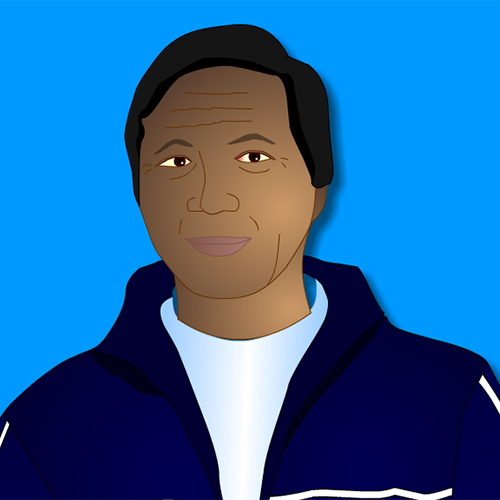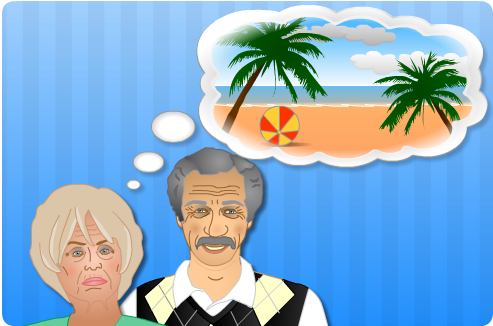Category: Advancing Modules
Jimmy’s choice of physical activity
Jimmy decides that he would like to attend the local gym. Although he has always intended joining, he had never got round to it. He is worried about getting there and knowing what to do in the gym. The therapists explain that initially they will accompany him and that once there he will have the support of a fitness instructor.
The therapists discuss how Jimmy could access the local gym, and participate in a fitness programme. They start by doing an environmental assessment to identify what Jimmy will have to achieve in order to access the gym.
Go through the slides to see what issues the therapists might need to consider with Jimmy’s house, the bus, pedestrian crossing and gym.
Getting out of the house
Jimmy is already walking independently around the house; working on his confidence, stamina and balance.
As he improves he progresses to walking outside with the therapists. His rehabilitation programme includes using his external steps, kerbs and walking on uneven pavements. His family are keen to support him and walk with him most days.
Gradually he is able to walk further and is confident enough to walk to the local shops safely and independently. He is keen to use public transport and in particular Jimmy would like to use a bus.
2 weeks following discharge
Jimmy is now at home. He can walk independently indoors but finds walking outside difficult. He is anxious about falling, feels that he lacks stamina and, as a result, doesn’t venture outside.
The CRT have visited Jimmy at home. Jimmy wishes to improve his indoor and outdoor mobility and increase his fitness levels. He reports having difficulty with fine motor skills e.g. writing and fastening clothing. The CRT plan to support Jimmy with his on-going rehabilitation.
There may be a number of ways to improve Jimmy’s fitness level. Consider the quiz below.
Q. Which of the following activities might Jimmy consider as appropriate to improve his fitness levels? Select true or false for each of the options listed below.
Case 4: Mr Jimmy Yu

Scenario
![]()
Mr Jimmy Yu is a 51 year old self employed financial advisor who has built up his business over the last few years. He regularly looks after his two young children whilst his wife is working.
Jimmy’s symptoms began while driving his car and he was stopped by the police. Initially the policemen thought he was under the influence of alcohol but they quickly realised that he was unwell and called an ambulance. On admission to hospital Jimmy was classified as having a posterior circulation stroke (POCS) affecting the cerebellum.
Following two weeks of in-patient rehabilitation he was discharged home with follow up from the community rehabilitation team (CRT).
NB: Please be advised that during the Covid-19 pandemic due to social distancing, meeting others and entry to venues, access to exercise programmes/classes may be restricted or provided in a different format (e.g. virtual). Please refer to your local Health Board for further guidance and information.
Key Messages
- Patient centred goal setting ensures patients are actively involved in their rehabilitation
- The key worker can be any member of the team and has identified responsibilities for managing the goal setting process for that patient
- Goal setting can be used as a tool to manage patients’ expectations
- A wheelchair is an alternative way of mobilising and can be used early on in rehabilitation
To learn more about self-management and the strategies which may be used in the process of self management visit STARs AM 15: Self Management.
Outcome

Alice has accepted that walking is something she may never manage. However, she has achieved her self propelling goal and is now wheelchair independent in the ward. She has had a successful home visit and her discharge is planned for 2 weeks time. Alice continues to set personal goals and is planning to return to Lanzarote in about 6 months time. She plans to access the Self Help4 Stroke self management resource and Mr Rowan has found the stroke for carers website very helpful.
As key worker how do you respond to this question?
Prior to your goal review meeting with Alice you had discussed self propelling wheelchair with your colleagues and had a review of the evidence.
Q. What did you find out about self propelling? Select Yes, No or Maybe for each of the statements below.
You explain to Alice that it has been suggested that the effort required to self propel a wheelchair may cause an increase in arm and leg stiffness but there is no clear evidence to support this. You have discussed this with the physiotherapist and she has agreed that she will closely monitor Alice for this. You feel that self propelling would allow Alice to be more independent, reduce the work load for her husband and allow her to go out socially. Additionally as she is doing other functional tasks throughout the day such as transferring and standing you do not believe that self propelling at this stage should negatively impact on her long term recovery.
After careful consideration and following your discussion with Alice, Alice agrees to have wheelchair self propulsion as a goal.
What are the outcomes of Alice’s goals?
Alice has been working toward her goals for the last 2 weeks. She is about to have another review meeting with her key worker. Have a look at her goal sheet to see how she has got on.
Alice’s goal sheet [.pdf, 30KB]
Two weeks later Alice and the keyworker have another goal review meeting. Go through the slides to move from scene to scene.
Writing goals with Alice
Following her review Alice was asked if her priorities were the same.
Alice told you – ‘I am happy with cooking because I know I can make a meal. I know I will be slower and will need some help from my husband but with the adaptive equipment I feel I can quite happily manage the cooking. My husband has already bought the one handed tin opener I think he bought it for himself, he likes his gadgets. The others I’d like to keep as the same but one thing I really would like to be able to do and I’m not sure how easy it would be, is to go out with my husband in the car. It would be great to be able to go for a drive, especially as it’s our daughter’s birthday in a few weeks and I’d really like to go and buy her a present’.
| Alice’s priorities and current status | |
| Alice’s priorities | Alice’s current abilities/status |
| 1. To walk around the house | When walking Alice needs help to get up from a chair to standing and needs help of two therapists to walk as she finds keeping her balance and moving her left leg difficult. She feels that if she had a higher chair to get up from and a walking aid she would be able to walk by herself. |
| 2. To be able to dress myself | Alice is able to put on her t-shirt and jumper getting help with her bra only. She needs total help with her lower clothes from one person. |
| 3. To be able to go to the toilet by myself (including getting to and on/off the toilet; adjusting clothes) | Alice transfers onto and off the toilet with the help of one person. She can stand with a rail but is anxious about letting go fearing she will fall. She requires help from one person to pull up and adjust her clothes. |
| 4. To be able to go out with my husband for a drive | Alice would like to be able to go out for a drive with her husband. She recognises she will need a wheelchair to go out but is concerned about accessing one and how to use it. |


